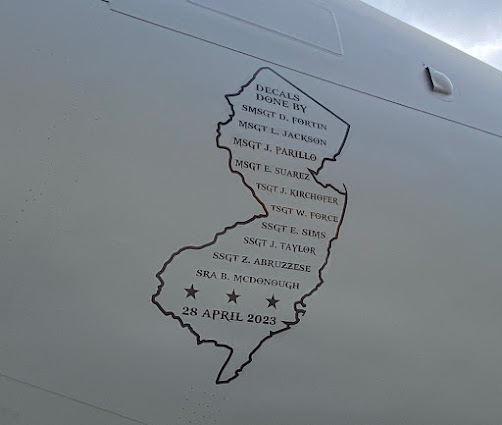Country music legend Buck Owens had a smash hit in 1964 with the song “I’ve Got a Tiger by the Tail.” That track always sprung to mind when I would see one of the United States Air Force’s most striking aircraft, the KC-135R Stratotanker designated 60-0366, clad in its bright tiger livery.
It was just four years before Owens topped the music charts
when this Stratotanker first flew, freshly constructed by Boeing Military
Airplanes in 1960
Nearly three decades
ago, 60-0366 was assigned to aerial refueling duty with the 108th
Wing at McGuire Air Force base, now a key component of Joint Base
McGuire-Dix-Lakehurst. Over the years since, one thing remained consistent:
home base for this 135 was always New Jersey. Until last week.
A strategic decision has been made which sees the remaining KC-135 workhorse tankers that had been based at McGuire now reassigned to other facilities. But seeing these aircraft go is far more than just a reallocation of military resources. Air crews and maintainers have bonded with these legendary planes, and their departure demanded a ceremony in recognition of their service.
That gathering took place last week in a hangar at McGuire.
And just outside, the final KC-135R stood ready to depart for a new home in
Maine.
This particular 135 – tail number 00366 – is one of the most
distinctive of USAF aircraft, with its bright orange-and-black tiger livery
honoring early aviator Captain Hobey Baker’s Princeton University heritage.
Baker, a test pilot in the years immediately following his distinguished
service in the first world war, was killed in a crash in 1918. Princeton’s
association with tiger graphics carried over onto this KC-135 in Baker’s
memory.
The guests assembled for the ceremony ranged from those on
hand to welcome 00366 when it first arrived at McGuire to those who have most
recently flown and maintained this aircraft. The walls of the hangar were
adorned with memorabilia and artefacts heralding the 108th Wing and
its colorful association with the mascot of Hobey Baker's alma mater.
Following the traditional Presentation of Colors, National
Anthem, and invocation, Senior Master Sergeant Donald Woods touched on many of
the facts that make up tail 60-0366’s incredible history. This KC-135 was the
408th Stratotanker to be built, and had flown in service to the USAF
for more than four decades before it arrived at McGuire and was placed into the
care of the 108th Wing in October 2007. Involved in numerous global
operations since that time, this aircraft has logged over 4500 flight hours.
Woods offered a fitting summary of the KC-135’s career: “To
this aircraft I say, job well done!”
Brigadier General Patrick Kenndey – who served as commander
of the New Jersey Air National Guard – then took the stage to introduce the
final flight crew and maintainers for this auspicious occasion, followed by an
additional appreciation for this aircraft and those who have served and do
serve in the 108th Wing.
Major General (Ret.) James McIntosh was then introduced as keynote
speaker, reflecting on his time as commander at McGuire Air Force Base – a
position that only came after more than 100 combat missions as KC-135 navigator
during the Vietnam conflict and more than 6,400 flying hours total.
“I was privileged to be a crew member of the crew that
brought the first KC-135 into McGuire,” McIntosh noted of the Stratotanker’s debut
New Jersey arrival 32 years ago. “It’s my honor to be here today as we say
goodbye to this airplane.”
Following a video commemorating the 108th Wing
and the KC-135, members of the 108th Fabrication Section unveiled a
stunning replica of KC-135R 60-0366 that will ensure memories are permanently
reflected through this work of art.
With the indoor ceremony complete, the hundreds of people on
hand emerged into bright sunshine and the sound of 00366, fired up and ready to
begin its final flight from McGuire. Forming a long, orderly line to the right
of the KC-135, the witnesses to this occasion offered final salutes as the huge
aircraft began to taxi toward its takeoff. Once airborne, the majestic
Stratotanker circled the base and made a final pass at low altitude in
farewell.
The 108th Wing will now begin a transition to the
newer Boeing KC-46 Pegasus tanker, even as talk heats up in the aerospace realm
over concepts like autonomous aerial refueling. But those are visions for the
future; for now, it’s entirely appropriate to focus on all those years of a job
well done thanks to the enduring KC-135.
Click on photos to see larger images.














